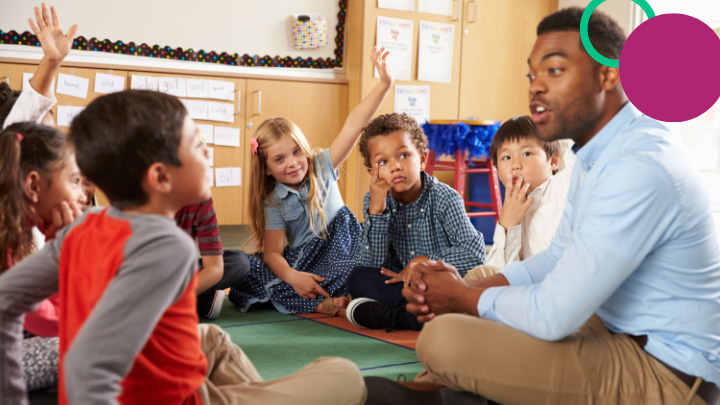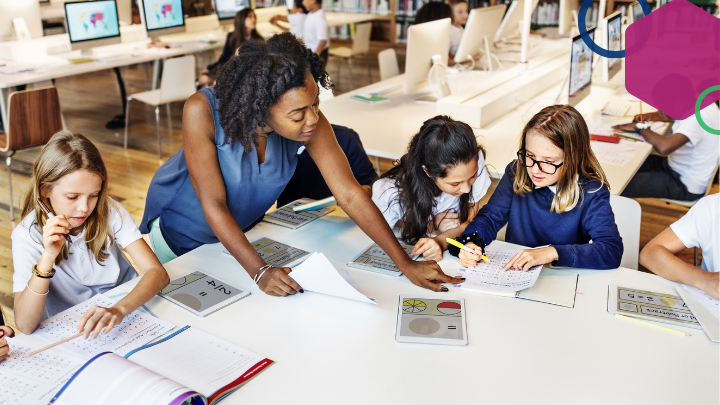Provide educators in multiple subject areas with the skills to encourage student-centered literacy by focusing on choice, collaboration, and ownership to improve literacy outcomes.
Every educator can implement student-centered writing, reading, and literacy skills in their classrooms, not just those teaching English Language Arts. Making an intentional shift toward student-centered classrooms in your district requires getting buy-in from all stakeholders, differentiated support for teachers, and an understanding of what learning data can be used to measure success. Our professional learning programs include four distinct phases to support student-centered literacy instruction across your district.
The BL Lab is the central station of your professional learning program. Teachers access resources and lesson plans, interact with their coach, and measure their progress and confidence in using their chosen outcomes in the classroom.
Teachers and leaders can take research-backed 60-minute courses as part of professional learning within their PLCs. Leaders can use these courses to provide teachers with differentiated support throughout the school year based on their experience level and goals.
Administrators gain a comprehensive view of their professional learning programs and easy access to the goals and progress of specific groups of educators.
Launching a student-centered literacy initiative starts with bringing your team together in-person to learn new concepts, language, and foundational practices around student-centered reading, writing, and literacy. Launch experiences include the teachers and leaders who will work together toward the common goal of improving student-centered literacy instruction across the district.
Teachers work with a coach who has experience with student-centered literacy practices to plan lessons, practice new strategies, and learn how to measure the impact for students. Instructional coaches use the Try-Measure-Learn method to offer educators personalized support as they work towards specific outcomes in the classroom.
Know what success looks like in the classroom, how to support teachers to achieve student-centered literacy outcomes, and build your ongoing professional learning plan for continuous improvement. Learning Walks are a non-evaluative tool that helps instructional leaders identify and celebrate new student-centered literacy teaching practices.
Gather teachers in collaborative Virtual Workshops so that they can work together towards the changes you want to see in classrooms. Virtual Workshops are facilitated by expert coaches to help educators create goals and an actionable plan to reach those goals for a sustained change in practice.
Building a Foundation for Literacy Success with Oral Language | Virtual
The Importance of Effective Phonological Awareness Instruction | Virtual
Planning for Effective Phonological Awareness Instruction in the SCL Classroom | Virtual
Effective First Instruction in Phonics: Developing Sound-Symbol Correspondence | Virtual
Building Student Agency and Authenticity through Writing | Virtual
The SCL Classroom: Supporting Developing Readers with Accessing Grade Level Text | Virtual
Leveraging Discourse for Learning | Virtual
Building Student Agency and Authenticity through Writing | Virtual
The SCL Classroom: Supporting Developing Readers with Accessing Grade Level Text | Virtual
Mastering Close Reading Strategies for Effective Text Analysis | Virtual
Making shifts in practice doesn’t happen overnight. Creating a meaningful change in student-centered literacy is often a one to three year arc, depending on your district’s goals and size. Our comprehensive professional learning programs incorporate in-person, virtual, group, and self-directed learning experiences throughout the full school year to help educators connect the dots between theory and practice. Our team will create a learning plan that is tailored to your district’s strategic plan and includes a mix of learning experiences backed by research and focused on specific outcomes.
Outcomes are the goals for all of our learning experiences. Each experience is tied to an outcome that makes the change in practice tangible and impactful for students and teachers. For student-centered literacy, we focus on helping educators of different grade bands achieve the below outcomes.
Outcome: I implement student-driven writing systems in my classroom.
Outcome: I leverage early learners’ oral language skills to support reading and writing development.
Outcome: I plan high-quality lessons for all research-based components of foundational literacy instruction (PA, Phonics, Vocabulary, Fluency, and Comprehension) that maintain high expectations for student performance.
Outcome: I plan high-quality learning experiences that continue to develop students’ ability to elicit meaning from oral and written language by consistently providing all students access to the necessary exposure and practice with language domains covering grade-level content.
Outcome: I monitor student learning on a continuous basis by analyzing both quantitative (i.e. Screeners, student work samples) and qualitative (i.e. Student conferencing) assessment measures that identify students’ strengths and needs.
Outcome: I cultivate an inclusive learning environment that leverages the individuality of my students’ cultural and linguistic identities through informed selection and/or development of instructional practices, materials, and resources for literacy.
Outcome: I develop engaging learning experiences for all my students by consistently incorporating student voice and opportunities for choice in my planning and daily literacy instruction.
Outcome: I focus on the grade-level expectations when planning differentiated learning experiences that target students’ strengths and needs.

Increase student reading and engagement with literature circles.

Support students in practicing reading fluently, assessing their own fluency, and reflecting on their reading with their teacher.

Teach students to discuss complex texts or topics and build their speaking and listening skills with Socratic Seminars.
Accelerate growth in your schools and stay ahead of the curve.
